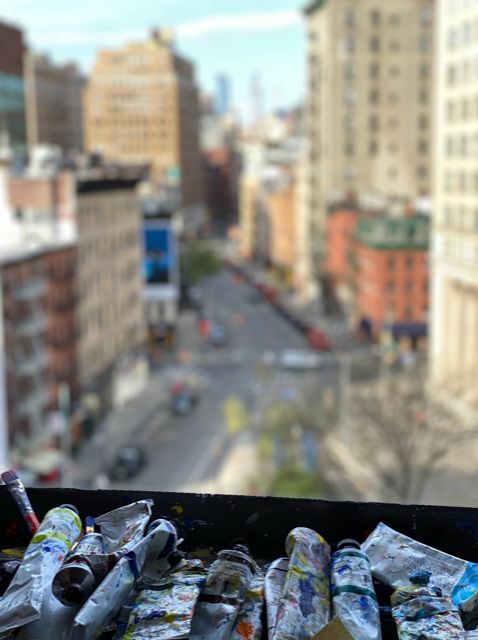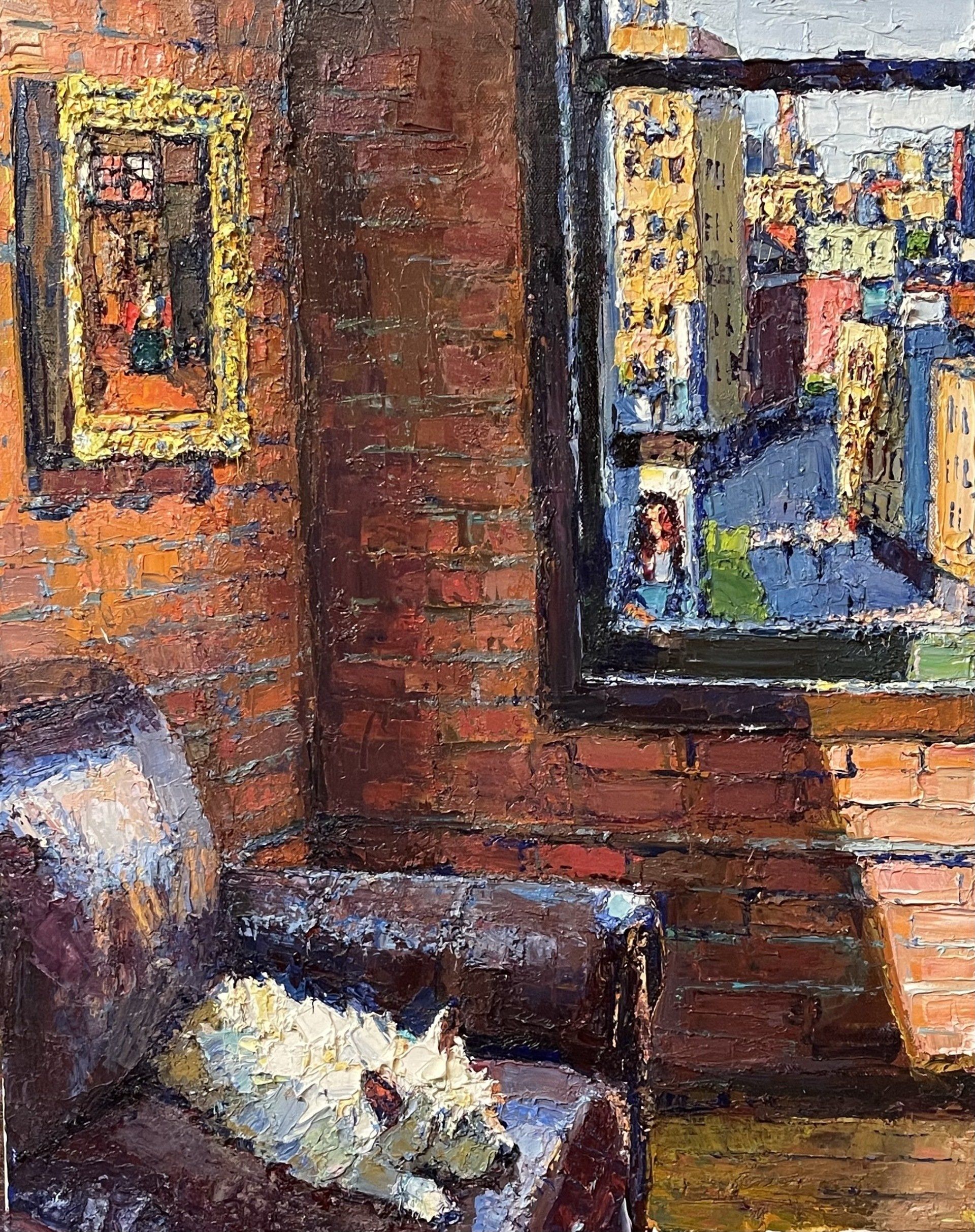“AN ‘INSIDE-OUT SELF-PORTRAIT’:
ALLEN HIRSCH’S PAINTINGS OF LAFAYETTE STREET”
By Yassana Croizat-Glazer, YCG FINE ART
In Allen Hirsch’s living room there is a window that measures 40 by 38 inches. Affixed to it is a small stained-glass oval from 17th-century Holland showing a woman by the sea holding a parrot with the word “Hope” written below her. The window faces north, providing a view of Lafayette Street stretching toward Prince Street and over the triangle of Lt. Petrosino Square—sandwiched beneath Kenmare and Spring Streets. The park takes its name from an officer who fought organized crime in the early twentieth century, one of many reminders of the fascinating history that permeates this corner of Nolita. In addition to being a painter, Hirsch is a developer, who played role in giving the area its present character by opening in 2005 a Mexican restaurant called La Esquina, buried beneath the sliver of a 100-year-old diner on Kenmare. Above it, there is a portrait painted by Hirsch of his beloved friend and capuchin monkey, the subject of Long Live Benjamin, an Emmy award-winning documentary (2018). Look still further up and you will see the window with its personification of Hope. Since moving into his loft in 1997, Hirsch has contemplated the view from that particular window countless times, processing it with the analytic bent of one who documents for posterity, as well as with an artist’s sensibility to that curious creature that is change.
In the 24 years since Hirsch first set foot in his home, much has happened outside that window. With reassuring predictability, the days have melted into nights, one season has dissolved into another—each of these phenomena always producing slightly different effects so that the view up Lafayette Street is never quite the same. There has been 9/11, a tragedy that has reshaped New York and the world in so many ways, not least through the various illnesses that have affected so many exposed to the air downtown at the time of the attacks and in their aftermath. There have been blackouts, including the one caused by Hurricane Sandy, a spectacular reminder to the city that no matter how grand it gets nature reigns supreme, and should be respected accordingly. In the past 24 years, outside Hirsch’s window, there have been so many lives fulfilled and disrupted, so many ideas that have flourished and ventures that have withered. All to a beautiful chorus of jackhammers blasting concrete, tires screeching and raucous conversations escaping from the batting doors of packed restaurants.
There has been silence too, most recently the eerie hush imposed by the lockdown of 2020, courtesy of a global pandemic the ramifications of which will take years to comprehend fully. For many months, Covid-19 quelled the familiar sounds of Hirsch’s corner of Nolita, and somehow, the artist was able to paint that quiet as well. Over the years, Hirsch has portrayed the view from his window in all its guises, whether New York was distressed or dazzling, and through this process has created a fascinating visual record of the city. Hirsch’s series is significant not only in terms of the city’s evolution and more broadly of urban history, but also as a tangible manifestation of the extraordinary resilience and ingeniousness of New York and its people. The compositions are equally telling in terms of Hirsch’s relationship to art history, in particular his connection to 17th-century Dutch artists, so skilled at city views (one need only think of Johannes Vermeer’s View of Delft of 1660-61). The serial nature of Hirsch’s paintings, and the artist’s preoccupation with faithfully capturing the visual effects of different times of day and year also call to mind Claude Monet’s process, as evidenced, for example, in his Haystack series of 1890-91 and his paintings of the façade of Rouen Cathedral made between 1892-94.
ALLEN HIRSCH: UP LAFAYETTE STREET presents 12 paintings from the series, made between 2007 and the spring lockdown of 2020. Each is revelatory in its own way, not only about this part of New York’s urban fabric, but also about the artist himself, whose presence is easily felt in the images’ often painterly surfaces. In Hirsch’s own words: “I look at the view painting as an ‘inside-out self-portrait’; the viewer slips on the mask of the artist to see the scene.” Everyone engages with New York in their own way; to see the city through Hirsch’s eyes is a powerful experience that helps us better understand our own point of view.



